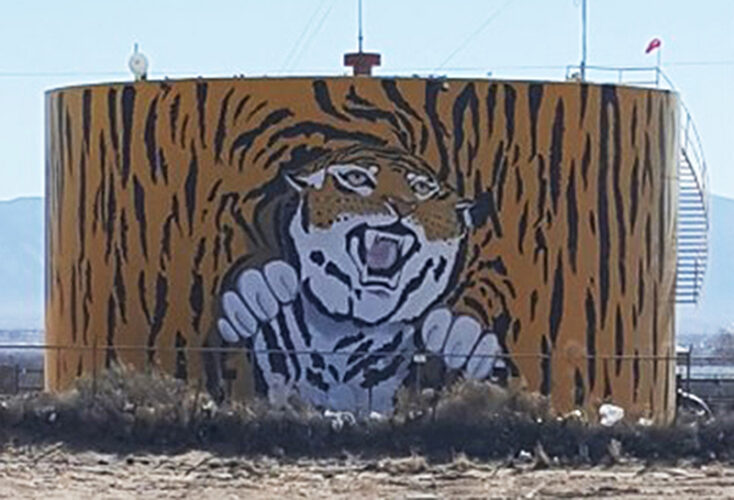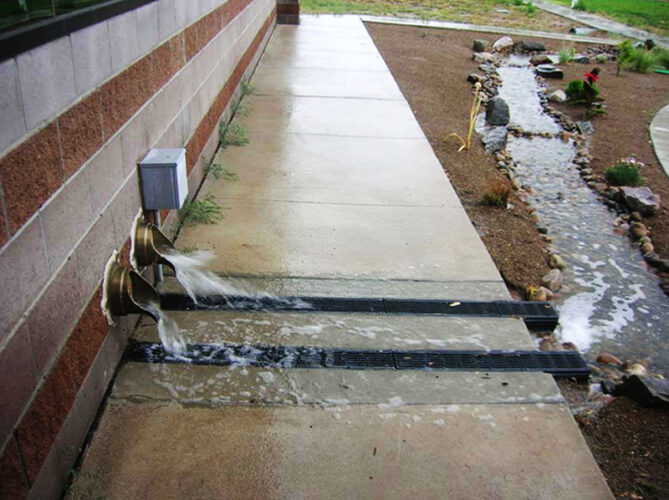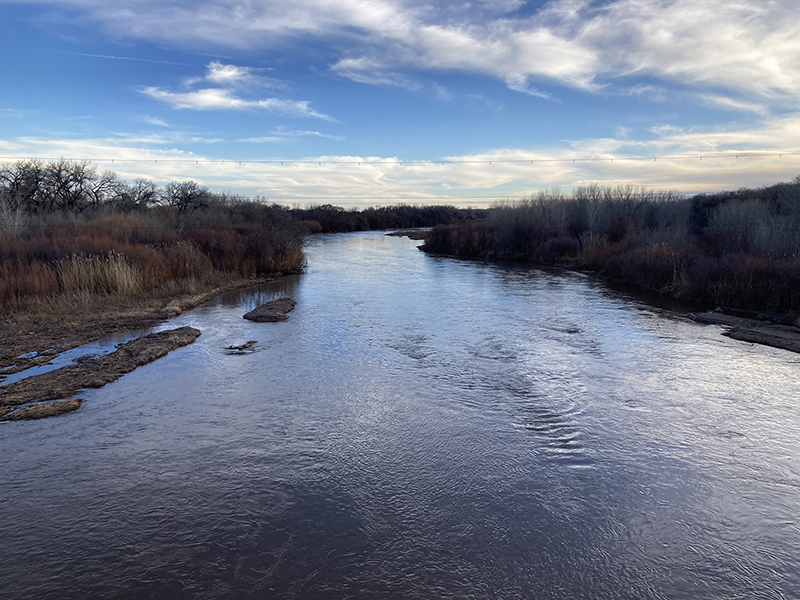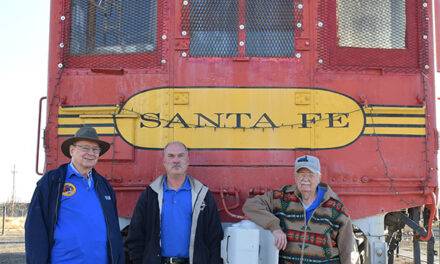Water and how it’s managed is crucial to community prosperity, especially in the Southwest where water, and access to it, is worth its weight in gold.
In Valencia County, water management varies across jurisdictions; however, one municipality takes water management to new heights through extensive policy and long-term planning.
Currently, the village of Los Lunas has the most robust and comprehensive water planning, management and conservation policies in Valencia County.
“The village is committed to making sure we are planning correctly and properly for our community,” said Los Lunas Public Works director Michael Jaramillo. “The approach of this organization, since I’ve been here, has always been to be proactive. We want to make sure that whatever we’re doing today supports what’s going to be needed tomorrow.”
The village currently utilizes a 40-year plan to acquire and hold water rights, an emergency water shortage plan, a water conservation plan and more, which can all be viewed on the village’s website.
“I think the village of Los Lunas is in a very strong position because of long-term planning,” said Los Lunas Mayor Charles Griego. “We’ve taken pains to ensure our system will be robust and efficient to serve the community as it grows and hopefully to attract other economic development prospects.”
Los Lunas’ water is supplied entirely from groundwater in the Rio Grande alluvium and the Santa Fe group aquifer, which supplies the Albuquerque metropolitan area and surrounding communities.

A figure from the village of Los Lunas water conservation plan from 2017 depicts the Los Lunas water system which utilizes five water wells and six water tanks. Image courtesy of the village of Los Lunas.
“The available information indicates that the regional aquifer near Los Lunas is capable of producing significant quantities of good quality water in areas relatively near the valley. Although the groundwater in some areas has a high arsenic concentration, the village system is now capable of treating this water, so this is no longer a limiting factor. To date, and for the projected future, there appear to be no limits to the village’s ability to meet its water needs from local groundwater,” the plan notes.
The village also takes opportunities when they arise to extend water and sewer utilities past the village limits to help connect people to treated water and do away with septic tanks which can lead to groundwater contamination problems.
Because of the rapid growth in Los Lunas, Jaramillo said it’s a responsibility of the village to maintain a 40-year water master plan. Griego said it was important to develop a water-rights strategy because it would be beneficial in the long term and protect their assets.
The village has a permit with the Office of the State Engineer to pump 6,320 acre-feet per year and divert 5677.42 AFY. An acre foot is about 326,000 gallons, which is enough water to cover an acre of land about 1-foot deep.
Jaramillo said Los Lunas has about 19,270 residents and the village water system serves more than 6,500 accounts. They also provide service to about 2,400 non-village residents and about 2,100 people at the Central New Mexico Correctional Facility.
Recent growth, however, has prompted the village to start looking at expanding their water rights capacity and revising the 40-year plan as the population has increased faster than initially expected.
“If we want to continue to have responsible growth, then we need to continue planning to make improvements, changes and modifications to our existing system,” Jaramillo said.
According to the plan, consultants anticipate the bulk of the water rights needed to meet the projected 40-year demand will be acquired through the village subdivision ordinance, which requires developers to transfer water rights to the village based on the impact of their subdivision. Griego said Los Lunas was one of the first communities in the state to enact this kind of ordinance.
“This ordinance, passed in 1977, has served as the primary vehicle for village water rights transfers. We estimate that more than 95 percent of the transferred irrigation rights were transferred in by developers,” the plan states. “The remaining 5 percent result from village purchases of very small parcels of water rights, most from within the Los Lunas area.”

The iconic tiger tank in Los Lunas is one of six water tanks in the Los Lunas water system. These tanks can hold about two million gallons of water.
Commercial users that have a large impact and industrial users are also required to transfer water rights subject to the approval of the state engineer. In recent years, concern has been expressed from the community about large water users, such as Niagara Bottling and Meta, taking up residence in Los Lunas and how this impacts supply.
“I think Niagara has not affected our ability to serve any other user within our village. It is a large user, but they have to comply with our regulations and state regulations,” said Griego. “We do monitor their usage and discharge and it has made us look at our ordinances as to how they are enforced, but also we’re not in the position to pick and choose ‘yes, you can come into the village and no you can’t’.”
Jaramillo said balancing economic development with water needs is something the village is conscious of and the way to address it is through policy and to continue to locate possibilities of water conservation within their operations.
“For example, we need an industrial water rate that is separate from a residential one. We have to create a process in which they’re paying a proportionate share, like an impact fee,” said Jaramillo. “They do pay impact fees, but the impact fee is set up on the meter size when it should be on usage. So there needs to be some policies put in place to balance the industrial growth.”
Jaramillo said it’s also important to be mindful that property taxes and gross receipts tax revenue generated from businesses that have come into Los Lunas are what helps fund public services, so maintaining a balance is important.
“It’s what funds our police and fire department, and all these services that make our community a nice place to live. If you don’t have those types of revenues, you don’t have those possibilities,” he said.
To help conserve water, the village’s landscaping ordinance requires commercial users to follow certain planting directives, including incorporation of xeriscape principles and standards for irrigation efficiency. Jaramillo said most companies who come to Los Lunas are very open to locating water conservation measures within their operations.
“Our goal is to ensure when talking to new businesses, we ask what their methods are to conserve water and what their plan is and we also try to find ways to support them,” said Jaramillo. “Many have done extremely well and even brought in water harvesting systems that use rainwater to irrigate landscape areas within their businesses.”
Jaramillo said locating opportunities for reclamation is also something they emphasize within the village. For example, all the car washes in Los Lunas utilize a reclamation process, which means they treat, clean and reuse the water until the water can’t be used further.
The Los Lunas administration building, fire department, recreation center and museum also use rainwater harvesting systems, with no other supplemental water, for landscape irrigation. Many of the public buildings in Los Lunas utilize xeric landscapes, which is a type of landscaping that reduces or eliminates the need for irrigation. There is even a xeric demonstration garden located at the village hall. Most of the public buildings within the village have also been retrofitted with low-flow or highly efficient toilets and faucets.

A rain water harvesting system collects water for landscape irrigation at one of the village of Los Lunas administration buildings. Photo courtesy of village of Los Lunas.
In 2008, the village completed the replacement of all existing residential and commercial meters with wireless radio read meters. Jaramillo said this has been a big advancement for water conservation in Los Lunas because possible leaks can be detected and addressed very quickly.
“We can look at water usage every hour through this system. If we get an abnormal read, we call them up and let them know. We’ve been able to catch a lot of water leaks this way,” said Jaramillo.
All irrigation systems in the village also run on a centralized computer system that allows them to program water usage specific to the plant life at each station to irrigate more effectively. Jaramillo said if the system detects a break, it shuts down and sends notice to staff.
Griego says it’s of great benefit for communities to have long-term water plans if they wish to expand.
“It puts us in a position where we can grow as a village, by providing an adequate supply to our residents and businesses,” said the mayor. “We’re not going to grow or be successful as a village unless we can provide them basic services, one being water.”
Rio Communities City Manager Martin Moore echoed Griego’s sentiment.
“As a city, we can’t stand still. Right now, we are in a mode of growth and in order to accomplish that we need to look at creating those plans,” Moore said.
Belen City Manager Roseann Peralta said the infrastructure they have in place currently is sufficient for the growth they have, but that could all change with proposed Interstate 25 interchange project that would open up development of the north side of city limits.
What if you can’t or don’t feel the need to grow as a municipality? Do you still need long-term water plans?
“We’re sitting pretty good the way things are set up now in Bosque Farms,” said Russell Walkup, mayor of Bosque Farms. “But it depends on society — it really does. Right now, there’s a want to not have high-density residential areas or apartments in Bosque Farms. If that changes, then yes, we need to look at how we can conserve water as more populace comes in, if it does.”
Peralta Town Clerk Kori Taylor said space wise, Peralta has no room to grow, but once the sewer system is complete, they may want to start developing more water management plans. Their main priority now though is to get residents off septic systems as the wastewater system develops.
Then there is the ever-present challenge climate change brings to the water supply in the Southwest. Being proactive in water conservation and management could make all the difference for communities.
“In recent years, New Mexico has experienced severe, multi-year droughts that threaten to negatively affect the water supply of the village and neighboring communities as dry weather conditions continue,” the Los Lunas water conservation plan reads. “Predictions for long-term weather patterns resulting from climate change also point toward a reduced water supply throughout the region.”
“Everything is about balance. Some people are like, ‘We’re not going to have water 100 years from now,’ but I can’t say that’s the case,” said Jaramillo. “I think we’re going to have the water, but it doesn’t mean we take advantage of it. We find ways to be responsible.”
Felina Martinez was born and raised in Valencia County. She graduated from the University of New Mexico in 2021. During her time at UNM, she studied interdisciplinary film, digital media and journalism. She covers the village of Los Lunas, Los Lunas Schools, the School of Dreams Academy and the town of Peralta.


















